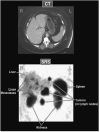Therapy of metastatic pancreatic neuroendocrine tumors (pNETs): recent insights and advances
- PMID: 22886480
- PMCID: PMC3754804
- DOI: 10.1007/s00535-012-0642-8
Therapy of metastatic pancreatic neuroendocrine tumors (pNETs): recent insights and advances
Abstract
Neuroendocrine tumors (NETs) [carcinoids, pancreatic neuroendocrine tumors (pNETs)] are becoming an increasing clinical problem because not only are they increasing in frequency, but they can frequently present with advanced disease that requires diagnostic and treatment approaches different from those used in the neoplasms that most physicians are used to seeing and treating. In the past few years there have been numerous advances in all aspects of NETs including: an understanding of their unique pathogenesis; specific classification systems developed which have prognostic value; novel methods of tumor localization developed; and novel treatment approaches described. In patients with advanced metastatic disease these include the use of newer chemotherapeutic approaches, an increased understanding of the role of surgery and cytoreductive methods, the development of methods for targeted delivery of cytotoxic agents, and the development of targeted medical therapies (everolimus, sunitinib) based on an increased understanding of the disease biology. Although pNETs and gastrointestinal NETs share many features, recent studies show they differ in pathogenesis and in many aspects of diagnosis and treatment, including their responsiveness to different therapies. Because of limited space, this review will be limited to the advances made in the management and treatment of patients with advanced metastatic pNETs over the past 5 years.
Conflict of interest statement
Figures


References
Publication types
MeSH terms
Grants and funding
LinkOut - more resources
Full Text Sources
Medical
Miscellaneous

